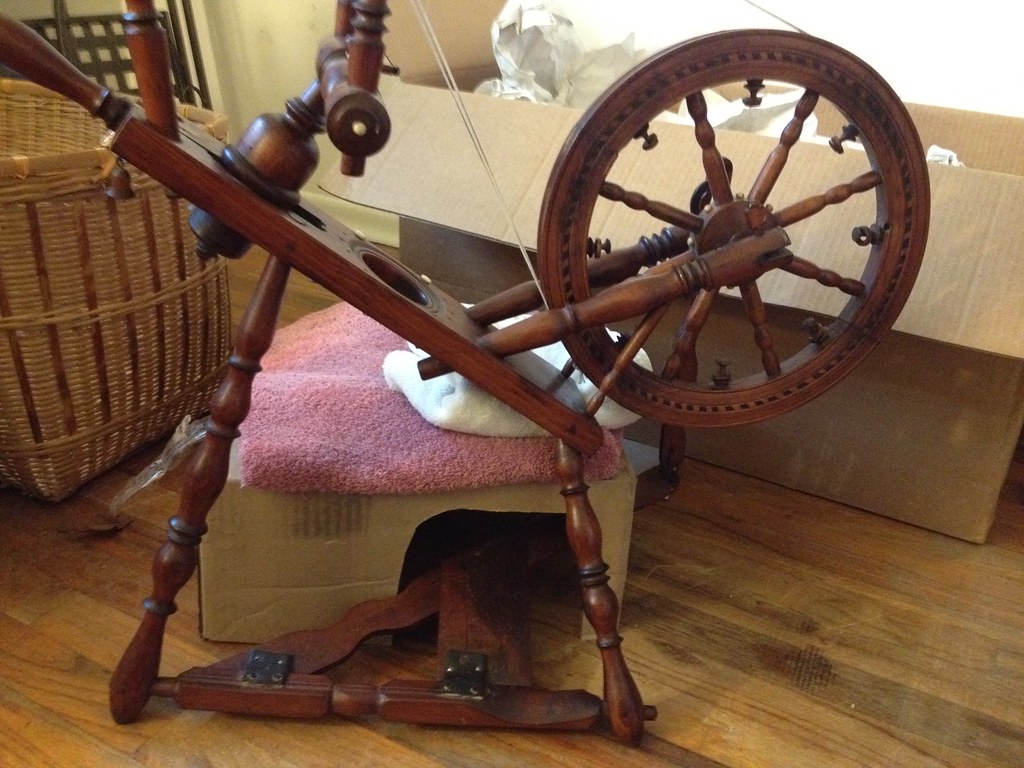 |
| Navajo-churro lamb |
A cosy home for spinning, knitting, and wool processing - the place for heritage wool from the Pacific Northwest, handspun wool yarn, and backyard angora rabbit fiber
Thursday, September 27, 2012
Monday, September 17, 2012
Weekend work
Friday, September 7, 2012
Art in the Pearl demo
On Sunday and Monday I brought Clemence out to Art in the Pearl in downtown Portland to demonstrate spinning for the masses. I was in the company of several talented fiber artists, and I am so grateful to them for having me there. Linda Hendrickson taught people (including me) how to do card weaving, Joel Weber brought a Leclerc folding loom and taught rug weaving, and Bhakti awakened my interest in the Russian support spindle that has been languishing in a little wooden box on my shelf for over a year. I so enjoy bringing the wheel out in public, and even more so in the company of others who love fiber arts. We were absolutely swamped with people for almost the entire time we were out there! Folks are fascinated by the spinning wheel and the looms. They ARE fascinating, indeed, but I'm more fascinated by the fact that we have become so isolated from the sources of common things - cloth, in this case - that we're surprised when we come in contact with them.
(And doesn't that wheel look BIG with little old me behind it!)
Salish Spinner
I went to an amazing estate sale last week and picked up some fiber arts equipment, supplies and books. I got many issues of Spin Off, cotton carpet warp, a $100 Macomber loom, and a broken Salish bulky spinner for $30, along with some hand knitted sweaters and a handmade cotton coverlet for my bed. The ladies who lived in that house were incredibly creative, and their interests were diverse. I hope that their spirits will guide my own creative endeavors using what they left behind.
Here is the Salish spinner:
I still have to make the axle support pretty (jigsaw and stain to reflect the color and shape of the original broken support) and I would like to make a nicer footman. Many of these wheels had broad leather drive belts, but I'm thinking of using a thick poly belt. The drive system relies on serious grip from the drive band and no slippage. It's a bobbin led wheel, where the drive band only acts on the bobbin groove, and the tension on the yarn from the spinner's hand drags the flyer around with the bobbin. It's a terribly inefficient system, but also dastardly simple. With a simple cord as a drive belt, I have to keep the tension very high and the whole system plentifully greased, which is wasteful of oil and hard on the wheel. I waxed the drive band with beeswax for grip, as I do with my great wheel, and this went a long way to reduce slippage. With a stretchy band, it should spin sweetly at a much lower tension. There is a string brake band at the front of the flyer, but I haven't needed it. The sheer weight of the bobbin maintains a reasonable take-up rate. This may change when it has a better drive band and runs more efficiently.
I see some serious rug weaving in my future!
Here is the Salish spinner:
When I bought it, it was missing its drive wheel and footman. I thought about bringing it to Ron Antoine for professional restoration, but my own love of tinkering led me to a different approach. The Salish Coast people would often attach the flyer and bobbin unit to an old treadle sewing machine stand, or they would build their own mechanism, depending on their means and what they had on hand. Many of the bulky spinners built later sport a cast iron drive wheel similar to the kind found on a treadle sewing machine. Off to eBay I went to obtain a sewing machine drive wheel, after measuring the one on my 1912 Singer to make sure that it would fit in the rather narrow space allowed for it. Attaching the drive wheel took some work, and I still would like to make bearings for a couple of places where metal moving parts are in direct contact with the wood.
How it spins, though! And the flyer and bobbin are massive! I've already packed the bobbin with Border Leicester yarn for a chunky grey rug.
 |
| Celia kitty for scale |
I still have to make the axle support pretty (jigsaw and stain to reflect the color and shape of the original broken support) and I would like to make a nicer footman. Many of these wheels had broad leather drive belts, but I'm thinking of using a thick poly belt. The drive system relies on serious grip from the drive band and no slippage. It's a bobbin led wheel, where the drive band only acts on the bobbin groove, and the tension on the yarn from the spinner's hand drags the flyer around with the bobbin. It's a terribly inefficient system, but also dastardly simple. With a simple cord as a drive belt, I have to keep the tension very high and the whole system plentifully greased, which is wasteful of oil and hard on the wheel. I waxed the drive band with beeswax for grip, as I do with my great wheel, and this went a long way to reduce slippage. With a stretchy band, it should spin sweetly at a much lower tension. There is a string brake band at the front of the flyer, but I haven't needed it. The sheer weight of the bobbin maintains a reasonable take-up rate. This may change when it has a better drive band and runs more efficiently.
I see some serious rug weaving in my future!
Monday, September 3, 2012
The things we learn...
A hardcore longdraw spinner, I've learned to comb top and spin worsted. I learned that I can draft quickly enough to do this on the Canadian wheel, so long as I am using a long-staple fiber. I learned that Clemence's drive band troubles are deeper than I suspected- she needs one double band around the pulley with a strand in each groove, and a separate, tighter band around the bobbin. NOW we can fly!
 |
| Dyed Tunis top and locks, fine Jacob fleece drying, and yarn! |
 |
| 3-ply! Merino and Mo |
Sunday, July 1, 2012
Fiber fatigue!
I just got back from two amazing back-to-back fiber events - the Black Sheep Gathering in Eugene and a 4-day spinning workshop with Judith MacKenzie. Both were amazing! I'm tired and don't have it in me to write much right now, but here are a couple of delicious images for now.
Natural dyeing workshop - pink is cochineal, blue is logwood, yellow is some crazy mushroom whose name I'll have to dig up:
The prettiest Romney fleece, and I already have a weakness for Romney:
Monday, June 18, 2012
My mail order bride
Clemence, the new wheel, is very much a mail order bride. I picked her because she was beautiful. While I already had a very utilitarian Canadian production wheel with poor finish and amazing spinning ability, I desired one of those grand ladies clad in cast iron and graceful wood turnings. Clemence had those, and she came from a spinner who vouched for her functionality, and so I had her sent over. We never spoke directly, but instead went through that fine matchmaker. She came to me all innocent, and I took her in, praised her loveliness, and we began to work together as partners. There the troubles began. She never suspected how many other wheels already had a place in my heart, and I'm afraid she may have been a bit jealous and insecure. I had no idea how finicky she would be, fussing with her driveband, chattering constantly, tossing the yarn right off her hooks, and keeping things at such high tension before she would let anything wind around her bobbin.
As it turns out, she was easily wooed with a couple of fine gifts. First, I bought her a beautiful claro walnut threading hook turned by the master wheelsmith, Carson Cooper. Then, in return for two days of weaving instruction, I was given a ball of hemp cordage, with which I made her a carefully fitted driveband. Now she accepts my requests and I hers, and we spin as a team with few hiccups and a gentle understanding between us. With a bit of polyfelt on her flyer shaft where the bobbin rests, she has even quieted her chattering to a gentle murmur. We speak softly to each other now.
 The hemp cordage, by the way, is incredible as a driveband. It takes hours upon hours to make, but is well worth the effort. It has more texture than typical driveband material, and a very slight amount of elasticity, as well as immense strength, so it grips the grooves but still allows some necessary slippage. There was an immediate and profound difference in the responsiveness of the wheel after installing the new band. I sewed the ends together, as the material is too thick to knot without jamming up the works.
The hemp cordage, by the way, is incredible as a driveband. It takes hours upon hours to make, but is well worth the effort. It has more texture than typical driveband material, and a very slight amount of elasticity, as well as immense strength, so it grips the grooves but still allows some necessary slippage. There was an immediate and profound difference in the responsiveness of the wheel after installing the new band. I sewed the ends together, as the material is too thick to knot without jamming up the works.Sunday, June 17, 2012
Handspun Border Leicester shawl
This is the product of three wheels, a month of spinning, and a week on the loom. It's my first twill, my first large weaving, my first weaving of all handspun - so many firsts, with mistakes to prove it. And I love it utterly.
Monday, June 11, 2012
The new gal
I got a second CPW! I am told that the style is consistent with the maker Vezina. She was shipped to me via Greyhound bus from Ohio. I have named her Clemence.
Wednesday, May 2, 2012
Tuesday, May 1, 2012
Flute Celeste
 |
| Extra lease sticks from the loom support plant trays full of drying fleece over the bathtub. Six trays could easily dry at once this way - as long as no one needs to take a shower! |
I've also been working on my combing skills in anticipation of this weekend's first Sheep to Yarn class at People's Co-op. For the first time, I used a spray bottle with water and a few drops of conditioner to keep the frizz down, and it works wonders on a couple of difficult, yet gorgeous, Shetland fleeces I've been hesitating to process. One of them has around an 8" staple length, and a bit longer in parts, and almost no crimp. It's too fine and long to card, and I've been nervous to even use the flicker on it. The problem is that there are a lot of trashy bits at the butt end of each staple, which makes me think that the sheep was about to molt, and that there's invisible scurf hiding in all that white wool and making things stick together. Once I comb it out, though, it's the closest thing to silk you'll find coming off a sheep, so the results are worth the extra effort to process it.
We're making progress on fixing up the room that will eventually be my studio. I'm hoping to have classes in there starting in mid-June. I pulled out my wool stash and thoroughly labeled the mystery buckets, then put the lot of it into storage in the garage, save a few things that I need to sort or that I'm currently processing and spinning. I also dyed some curtains today, although getting the right depth of color was difficult. I think that I will make some bands on the inkle loom to accent the curtains. I need more rugs, so my first thought, of course, is that I should finally build my Navajo loom and start making them myself. I wish I had more time! But I am so grateful for the time I have.
Good friends
Monday, April 30, 2012
Warping and spinning
Home built warping board Take Two is working well. I've been winding warps for a shawl from handspun Border Leicester wool, and I just ordered another pound of the stuff for the weft from SuDan Farm. Turns out that a big shawl takes a lot of yarn - who knew? It's a good thing that I spin by the pound! It's also a good thing that I spin on a Canadian Production Wheel that just plows through wool.
Sadly, I didn't take photos of today's adventure. I went to my friend's workplace, which is a local college's veterinary school, and got to take as much fleece as I wanted out of the barn. All of the sheep were sheared on Friday, and, while they're a motley mix and not raised for handspinners, I think that I got some decent Romney cross wool from the lot. I brought home four fleeces and a parking citation... and a Navajo rug that I found for $10 at Goodwill!
More photos to come when there's more natural light - a friend gave me a Norwegian Princess spinning wheel as a maybe long-term loan, maybe to keep, who knows? It's dreamy.
Sadly, I didn't take photos of today's adventure. I went to my friend's workplace, which is a local college's veterinary school, and got to take as much fleece as I wanted out of the barn. All of the sheep were sheared on Friday, and, while they're a motley mix and not raised for handspinners, I think that I got some decent Romney cross wool from the lot. I brought home four fleeces and a parking citation... and a Navajo rug that I found for $10 at Goodwill!
More photos to come when there's more natural light - a friend gave me a Norwegian Princess spinning wheel as a maybe long-term loan, maybe to keep, who knows? It's dreamy.
Wednesday, April 25, 2012
Inkle weaving!
I think that it took me two hours from start to finish to weave a 5' long band. I have big plans to weave dog leashes out of Icelandic and Navajo churro sheep's wool with colorwork from the natural colors of the fleeces. This band is rather too soft to be a durable leash, but it will be my prototype for sewing the ends, thinking about the length of the leash, etc.
Friday, April 20, 2012
Weaving on the Allen loom
My friend Xtine sold me her grandmother's much-loved and long-idle loom three years ago, and I've spent the interim longing to weave and being far too intimidated by the idea of warping it on my own.
Now, armed with books and the Internet, I am ready. On Saturday I built a warping board... on Sunday I rested, on Monday I warped, and on Tuesday morning before work I wove a scarf. Just like that!
 |
| Warp: Cascade 220, Weft: Handspun BFL and silk |
Now that I've woven on this loom, it went from seeming absolutely massive to looking rather small - the weaving width is only 30"! I'm wondering how I can fit a 45"+ floor loom into my space...
Friday, April 13, 2012
Signs of spring
 |
| Harvest of overwintered brassicas |
I've been working on the garden for the past week. I'm starting dye plants from seed, so there's indigo yet to be started, and madder and dyer's chamomile well on their way to being large enough to be planted out. Potatoes have gone in, although I just bought more. There's a crabapple tree and a dwarf apple coming home tomorrow, and I planted a new grape vine in a 5-gallon bucket to let it grow more before I submit it to the rambunctious trampling of Theo, the dog.
The two main raised beds are too full with overwintered broccoli, kales, green onions, and garlic to be added to at all, so I've taken up a two-pronged strategy of eating as much as I can and planting in big buckets along the fence line. I managed to tuck in a few chioggia beet seedlings among the lettuces, and all the peas and some herb plants are in the containers. Potatoes are in big bins, as are strawberries.
FYI, If you want an amazing overwintered broccoli, plant Purple Peacock Sprouting Broccoli. The leaves are just as tender and delicious as the florets!
 |
| SO much broccoli - this is not the purple peacock - I can't remember which variety this is |
A new hen found us. She's lost and misses her flock, and she's the friendliest chicken I've met. Also perhaps the most beautiful. I hope that her owner finds her (we posted on craigslist) since she's feeling lonely. I'm happy to keep her if she integrates with the flock, though.
And, of course, I've been spinning and preparing wool. I have a wool processing class coming up at the co-op, and we'll be working with a local Romney fleece. I also have been combing a 4-year-old longwool fleece I had put away dirty and recently unearthed and washed. It's the most gorgeous thing, and I can't believe that it sat on a shelf for so long. In fact, it was one of the first two fleeces I ever bought.
Tuesday, April 3, 2012
Striped rovings
I made some more striped roving on the drum carder today. I love seeing how this stuff comes out when I pull it through the diz. I find it very difficult to photograph my alpaca roving without it looking too messy. It's so fluffy that it looks like I carded it poorly, while the wool comes out looking tidy after one pass through the carder.
The Ancient Art of Spinning Flax
I taught myself to wet spin line flax a few days ago at the request of a dear friend with an important weaving project. I find it positively addictive, and it's getting me reacquainted with my Country Craftsman wheel, which is the only working wheel in my possession that has a distaff that can hold a flax strick. When the wedding wheel is fixed, it can become my go-to flax wheel.
Flax practically spins itself, and it wants to make very fine thread. The tricky part for me has been making it spin a bit thicker that it likes, as my friend is a beginning weaver and is making a shawl, not a tablecloth, so I gather that finer is not better for her right now. I think that my next piece of spinning equipment to build is one of those hanging water gourds for wetting my fingers as I spin.
Flax and weaving feel to me like the gates to The Mysteries of the ancient women who made the fabric of our species - the clothing, the tents, the sails... When I feel the flax twisting between my fingers, I can almost hear their ghost wheels and spindles, turning endlessly through time.
The Matter of the Weasel
When I finish spinning a bobbin full of yarn, I wind off onto an antique clock reel, aka, spinner's weasel. I LOVE this tool. It's beautiful and sturdy, turns smoothly, and, yes, it does pop, but only after about 350 yards. The problem with my wonderful, wonderful weasel is the size of the finished skeins - 94"!
There isn't a tabletop or umbrella swift that can handle one of these skeins (nor would you want one, as it would be HUGE), and the reel is most definitely only a reel, and not a swift. That is, it is strong and slow, and properly turns in only one direction. It is not adjustable, so a skein pulled off the reel, once washed and thwapped a few times on the shower walls, no longer fits as it has shrunk - generally just enough to give me hope that I can stretch it back on without actually fitting when I try. I've been improvising for a while, reluctant to go back to the small tabletop swift as my standard, rather inconvenient reel. Ergonomically, I've found no way to set it up that is comfortable and efficient, and I only want to wind skeins on it that I plan on selling, as most buyers probably will be just as able to deal with 94" skeins as I have been.
Then I had a flash of inspiration: Squirrel Cage Swift! Of course - it takes up very little floor space, moving the length of the skein vertically. It's also reputed to be useful for sorting out tangled, twisted skeins - and I've purchased just enough of those to be interested in anything that makes winding them a less maddening process.
The problem with this squirrel cage swift idea is the expense. It's one of the more intricate and therefore expensive swift styles, and I'm spending more than I should setting up the basics of my teaching and wool business. So today, after bunny shearing funtimes, I went off to the hardware store for parts.
 |
| Still need to sand, glue, and finish... |
Consider the result a prototype. It cost me less than $25 and taught me the importance of owning a drill press if you want to do this sort of project. I wish so badly that I had one about two hours ago so that all of my holes wouldn't be so funky. Really, the whole device was poorly built, and I learned a lot in the process. I hope to make a second one using the right tools and good hardwoods.
BUT... It works! That's a 94" skein on there, and the swift turns smoothly. At some point, I'll make #2, but this beast will probably do for a good long time.
Sunday, April 1, 2012
German wedding wheel
This wheel belonged to a woman who lives near Seattle. As far as we can tell, it was in her family since it was made, and they brought it to New York from Germany in 1900. When I picked it up, the owner gave me the most precious pieces of family history to go with it - copies of photos from a century ago and a poem about childhood memories with the wheel written by a cousin.
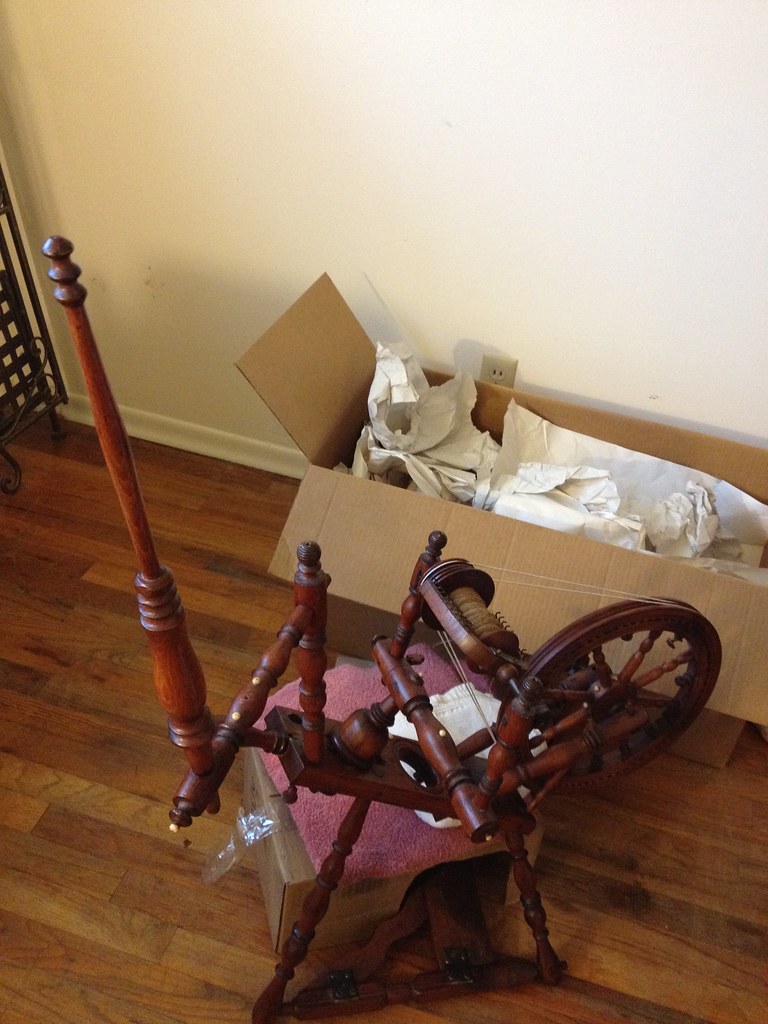 |
| Distaff! |
It has two major breaks - one in the table, and one where a creative soul tried to fix a loose leg with gorilla glue and screws! The bobbin is frozen on the flyer, and the flyer has an old repair where it broke in half, as so many of them do. The condition of the wood it beautiful, and I think that it will be stunning and functional once repaired. I have an appointment with the wheel doctor on Thursday...
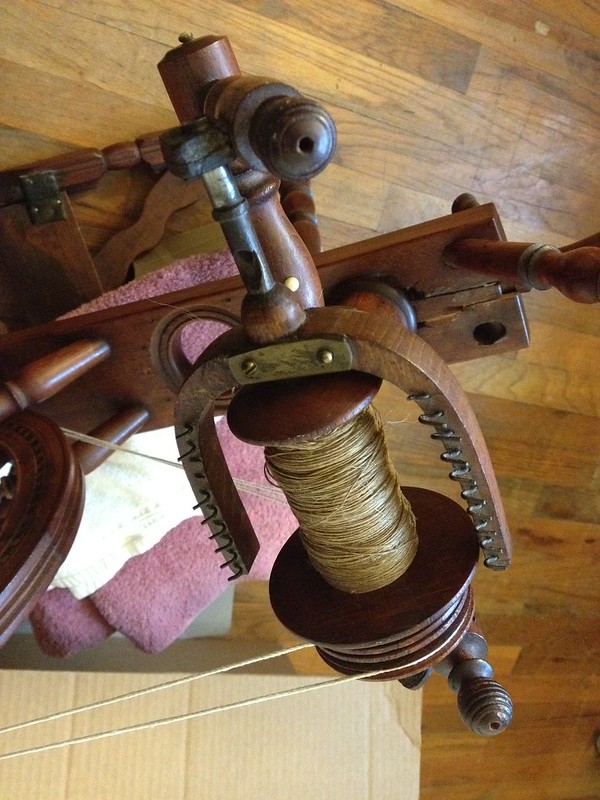 |
| Century-old spun flax on the flyer (with old repair plate) |
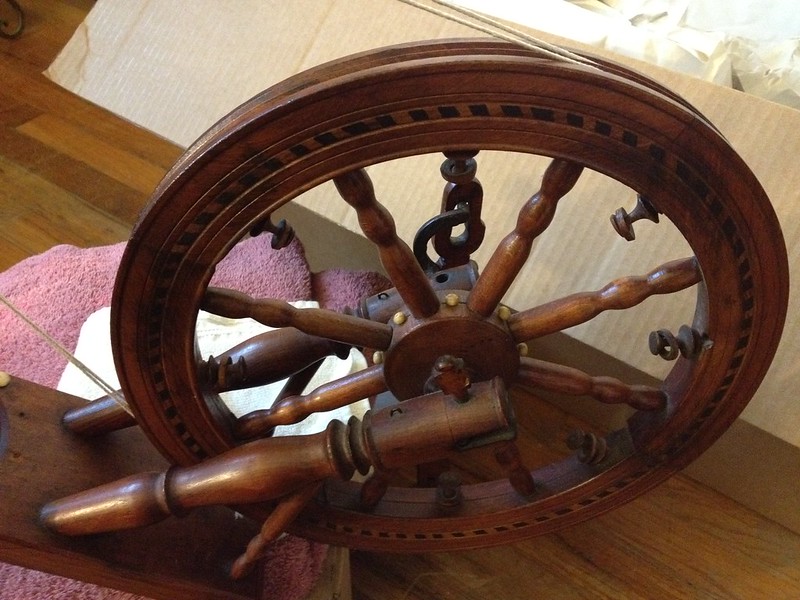 |
| Captive rings! |
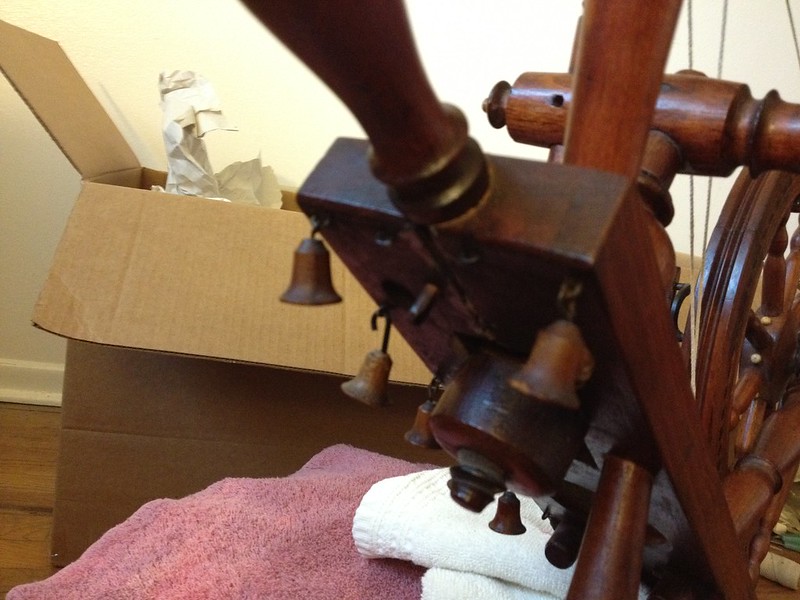 |
| Carved wooden bells! |
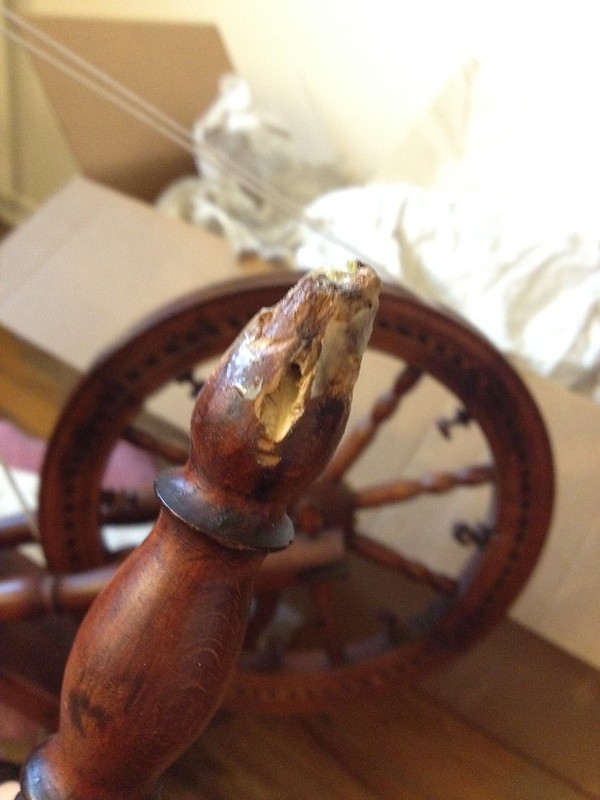 |
| Looks like it was attacked by a beaver, but, no - just dad and an impact driver. |
Wheels come in waves
In the last two weeks, I have obtained my dream wheel, and one whose history and beauty took my breath away. The dream wheel:
He is a Ouellet ("Willet") Canadian production wheel. I named him Germain after many of the men in my grandmother's side of the family, all of whom were living in the same region of Quebec as these wheels were made.
The first time I spun on Germain, it was like he was a part of my body enabling me to spin exactly how I best like to spin - fast, long draw, with big, sweeping arm movements. I tend to get cramped when I sit too long in a closed position, so I spin sidesaddle and keep my hands rather far from the orifice. Big movements, lots of control - they're key for me to stay limber and spin consistently.
The German wedding wheel is up next!
He is a Ouellet ("Willet") Canadian production wheel. I named him Germain after many of the men in my grandmother's side of the family, all of whom were living in the same region of Quebec as these wheels were made.
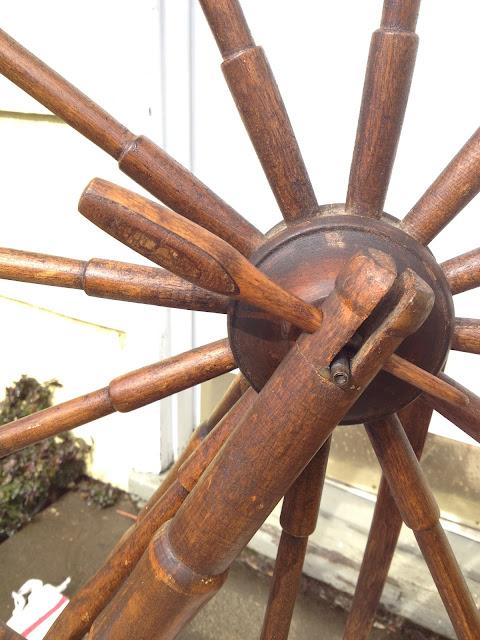 |
| Look at the knot in that retaining pin! |
The first time I spun on Germain, it was like he was a part of my body enabling me to spin exactly how I best like to spin - fast, long draw, with big, sweeping arm movements. I tend to get cramped when I sit too long in a closed position, so I spin sidesaddle and keep my hands rather far from the orifice. Big movements, lots of control - they're key for me to stay limber and spin consistently.
 |
| Border Leicester wool roving spun long draw on Day 1 with the wheel! |
Subscribe to:
Posts (Atom)






















.JPG)









